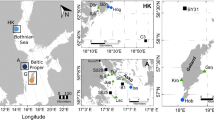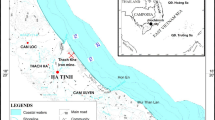Abstract
Stable nitrogen isotope ratios of five mussel species from littoral and pelagic areas were investigated with different trophic states in the eutrophic Lake Taihu, the third largest lake in China. Interpopulation variability for these mussels was relatively small in foot tissues because of the slow turnover time. Seasonal and spatial variations among the δ 15N values of mussels might be due in part to the natural variation in δ 15N values of potential food sources and the variation in the amount of human pollutions discharged into various locations of the lake. Although the increase of mussel δ 15N values was accompanied by the increase of nutrient concentrations in most situations in this study, statistically significant correlations were only 22% of the total correlations in this survey, which might be attributed to the different time-scale variations in nutrient concentrations and isotope signatures and the unknown details of the trophic pathways and metabolism for incorporation of these nutrients.
Similar content being viewed by others
References
APHA (1995). In A. D. Eaton, L. S. Clescerl & A. E. Greenberg (Eds.), Standard methods for the examination of water, wastewater (19th ed.). Washington, DC: American Public Health Association.
Bode, A., Alvarez-Ossorio, M. T., & Varela, M. (2006). Phytoplankton and macrophyte contributions to littoral food webs in the Galician upwelling estimated from stable isotopes. Marine Ecology Progress Series, 318, 89–102. doi:10.3354/meps318089.
Cabana, G., & Rasmussen, J. B. (1996). Comparison of aquatic food chains using nitrogen isotopes. Proceedings of the National Academy of Sciences of the United States of America, 93, 10844–10847. doi:10.1073/pnas.93.20.10844.
Cole, M. L., Valiela, I., Kroeger, K. D., Tomasky, G. L., Cebrian, J., Wigand, C., et al. (2004). Assessment of a δ 15N isotopic method to indicate anthropogenic eutrophication in aquatic ecosystems. Journal of Environmental Quality, 33, 124–132.
Correll, D. L., Jordan, T. E., & Weller, D. E. (2001). Effects of precipitation, air temperature, and land use on organic carbon discharges from Rhode River watersheds. Water, Air, and Soil Pollution, 128, 139–159. doi:10.1023/A:1010337623092.
Costanzo, S. D., O’Donohue, M. J., Dennison, W. C., Loneragan, N. R., & Thomas, M. (2001). A new approach for detecting and mapping sewage impacts. Marine Pollution Bulletin, 42, 149–156. doi:10.1016/S0025-326X(00)00125-9.
Costanzo, S. D., O’Donohue, M. J., & Dennison, W. C. (2003). Assessing the seasonal influence of sewage and agricultural nutrient inputs in a subtropical river estuary. Estuaries, 26, 857–865. doi:10.1007/BF02803344.
Fan, C. X., Hu, W. P., Phillip, W. F., Chen, Y. W., Qu, W. C., & Zhang, L. (2005). Carbon dioxide partial pressure and carbon fluxes of air–water interface in Lake Taihu, China. Chinese Journal of Oceanology and Limnology, 23, 29–38. doi:10.1007/BF02845140.
Gao, G., Qin, B. Q., Sommaruga, R., & Psenner, R. (2007). The bacterioplankton of Lake Taihu, China: Abundance, biomass, and production. Hydrobiologia, 581, 177–188. doi:10.1007/s10750-006-0511-7.
Gosner, K. L. (1971). Guide to identification of marine and estuarine invertebrates; Cape Hatteras to the Bay of Fundy. New York, USA: Wiley Interscience.
Gorokhova, E., & Hansson, S. (1999). An experimental study on variations in stable carbon and nitrogen isotope fractionation during growth of My sis mixta and Neomysis integer. Canadian Journal of Fisheries and Aquatic Sciences, 56, 2203–2210. doi:10.1139/cjfas-56-11-2203.
Hawkins, A. J. S. (1985). Relationships between the synthesis and breakdown of protein, dietary absorption and turnovers of nitrogen and carbon in the blue mussel, Mytilus edulis L. Oecologia, 66, 42–49. doi:10.1007/BF00378550.
Heaton, T. H. E. (1986). Isotopic studies of nitrogen pollution in the hydrosphere and atmosphere: A review. Chemical Geology, 59, 87–102. doi:10.1016/0009-2541(86)90046-X.
Jordan, T. E., & Valiela, I. (1982). A nitrogen budget of the ribbed mussel, Geukensia demissa, and its significance in nitrogen flow in a New England salt marsh. Limnology and Oceanography, 27, 75–90.
Kaushal, S. S., Lewis, W. M., & McCutchan, J. H. (2006). Land use change and nitrogen enrichment of a rocky mountain watershed. Ecological Applications, 16, 299–312. doi:10.1890/05-0134.
Lake, J. L., McKinney, R. A., Osterman, F. A., Pruell, R. J., Kiddon, J., Ryba, S. A., et al. (2001). Stable nitrogen isotopes as indicators of anthropogenic activities in small freshwater systems. Canadian Journal of Fisheries and Aquatic Sciences, 58, 870–878. doi:10.1139/cjfas-58-5-870.
Lancaster, J., & Waldron, S. (2001). Stream isotope values of lotic invertebrates: Sources of variation, experimental design, and statistical interpretation. Limnology and Oceanography, 46, 723–730.
Macko, S. A., & Ostrom, N. E. (1994). Pollution studies using stable isotopes. In: K. Lajtha & R. H. Michener (Eds.), Stable isotopes in ecology and environmental science (pp. 45–62). London: Blackwell ScientiWc.
McClelland, J. W., & Valiela, I. (1998). Linking nitrogen in estuarine producers to land-derived sources. Limnology and Oceanography, 43, 577–585.
McClelland, J. W., Valiela, I., & Michener, R. H. (1997). Nitrogen-stable isotope signatures in estuarine food webs: A record of increasing urbanization in coastal watersheds. Limnology and Oceanography, 42, 930–937.
McKinney, R. A., Lake, J. L., Charpentier, M. A., & Ryba, S. (2002). Using mussel isotope ratios to assess anthropogenic nitrogen inputs to freshwater ecosystems. Environmental Monitoring and Assessment, 74, 167–192. doi:10.1023/A:1013824220299.
McMahon, R. F. (1991). Mollusca: Bivalva. In J. H. Thorp & A. P. Covich (Eds.), Ecology and classification of North American freshwater invertebrates. Harcourt Brace Janovich, San Diego, California, USA: Academic Press.
Murphy, J. R., & Riley, J. P. (1962). A modified single solution method for the determination of phosphorus in natural waters. Analytica Chimica Acta, 27, 31–36. doi:10.1016/S0003-2670(00)88444-5.
Nixon, S. W. (1995). Coastal eutrophication: A definition, social causes, and future concerns. Ophelia, 41, 199–220.
Paerl, H. (1988). Nuisance phytoplankton blooms in coastal estuarine and inland waters. Limnology and Oceanography, 33, 823–847.
Paerl, H. (1997). Coastal eutrophication and harmful algal blooms: Importance of atmospheric deposition and groundwater as “new” nitrogen and other nutrients. Limnology and Oceanography, 42, 1154–1165.
Pennock, J. R., Velinski, D. J., Ludham, D. J., Sharp, J. H., & Fogel, M. J. (1996). Isotope fractionation of ammonium and nitrate during the uptake by Skeletonema costatum: Implications for the δ 15N dynamics under bloom conditions. Limnology and Oceanography, 41, 451–459.
Post, D. M. (2002). Using stable isotopes to estimate trophic position: Models, methods and assumptions. Ecology, 83, 703–718.
Pu, P. M., Hu, W. P., Wang, G. X., Zhang, S. Z., Hu, C. G., & Yan, J. S. (1998). The new strategy for improving the aqua-ecological environmental in Lake Taihu Basin, China. How can we solve the problem of lack of qualified water and deterioration of environment and natural resources in Lake Taihu basin. Journal of the Lake Sci, 10, 47–58.
Raikow, D. F., & Hamilton, S. K. (2001). Bivalve diets in a Midwestern US stream: A stable isotope enrichment study. Limnology and Oceanography, 46, 514–522.
Schlacher, T. A., Liddell, B., Gaston, T. F., & Schlacher-Hoenlinger, M. (2005). Fish track wastewater pollution to estuaries. Oecologia, 144, 570–584. doi:10.1007/s00442-005-0041-4.
Showers, W. J., Eisenstein, D. M., Paerl, H., & Rudek, J. (1990). Stable isotope tracers of nitrogen sources to the Neuse River, North Carolina. Water Resources Research Institute, Tech Rep 253.
Showers, W. J., Karr, J., & Plaia, G. (1999). Stable nitrogen isotopic tracers of nutrient sources to the North Carolina coastal plain. In Proceedings of 1999 animal waste management symposium, (pp. 70–79). College of Agriculture and Life Sciences, North Carolina State University, Raleigh, January 27–28.
Smith, V. H., Tilman, G. D., & Nekola, J. C. (1999). Eutrophication: Impacts of excess nutrient inputs on freshwater, marine, and terrestrial ecosystems. Environmental Pollution, 100, 179–196. doi:10.1016/S0269-7491(99)00091-3.
Steffy, L. Y., & Kilham, S. S. (2004). Elevated δ 15N in stream biota in areas with septic tank systems in an urban watershed. Ecological Applications, 14, 637–641. doi:10.1890/03-5148.
Udy, J. W., & Dennison, W. C. (1997). Physiological responses of seagrasses used to identify anthropogenic nutrient inputs. Marine and Freshwater Resources, 48, 605–614. doi:10.1071/MF97001.
Wayland, M., & Hobson, K. A. (2001). Stable carbon, nitrogen, and sulfur isotope ratios in riparian food webs on rivers receiving sewage and pulp-mill effluents. Canadian Journal of Zoology, 79, 5–15. doi:10.1139/cjz-79-1-5.
Xu, J., Li, S., & Xie, P. (2005a). Differences in δ 13C and i15N of particulate organic matter from the deep oligotrophic Lake Fuxian connected with the shallow eutrophic Lake Xingyun, China. Bulletin of Environmental Contamination and Toxicology, 74, 281–285. doi:10.1007/s00128-004-0581-z.
Xu, J., Xie, P., Zhang, M., & Yang, H. (2005b). Variation in stable isotope signatures of seston and a zooplanktivorous fish in a eutrophic Chinese lake. Hydrobiologia, 541, 215–220. doi:10.1007/s10750-004-5709-y.
Xu, J., Zhang, M., & Xie, P. (2007a). Size-related shifts in reliance on benthic and pelagic food webs by lake anchovy. Ecoscience, 14(2), 170–177. doi:10.2980/1195-6860(2007)14[170:SSIROB]2.0.CO;2 .
Xu, J., Zhang, M., & Xie, P. (2007b). Stable carbon isotope variations in surface bloom scum and subsurface seston among shallow eutrophic lakes. Harmful Algae, 6(5), 679–685. doi:10.1016/j.hal.2007.02.002.
Xu, J., Zhang, M., & Xie, P. (2008). Stable isotope changes in freshwater shrimps (Exopalaemonmodestus and Macrobrachium nipponensis): Trophic pattern implications. Hydrobiologia, 605, 45–54. doi:10.1007/s10750-008-9299-y.
Author information
Authors and Affiliations
Corresponding author
Rights and permissions
About this article
Cite this article
Wen, Z., Xie, P. & Xu, J. Mussel isotope signature as indicator of nutrient pollution in a freshwater eutrophic lake: species, spatial, and seasonal variability. Environ Monit Assess 163, 139–147 (2010). https://doi.org/10.1007/s10661-009-0823-y
Received:
Accepted:
Published:
Issue Date:
DOI: https://doi.org/10.1007/s10661-009-0823-y




